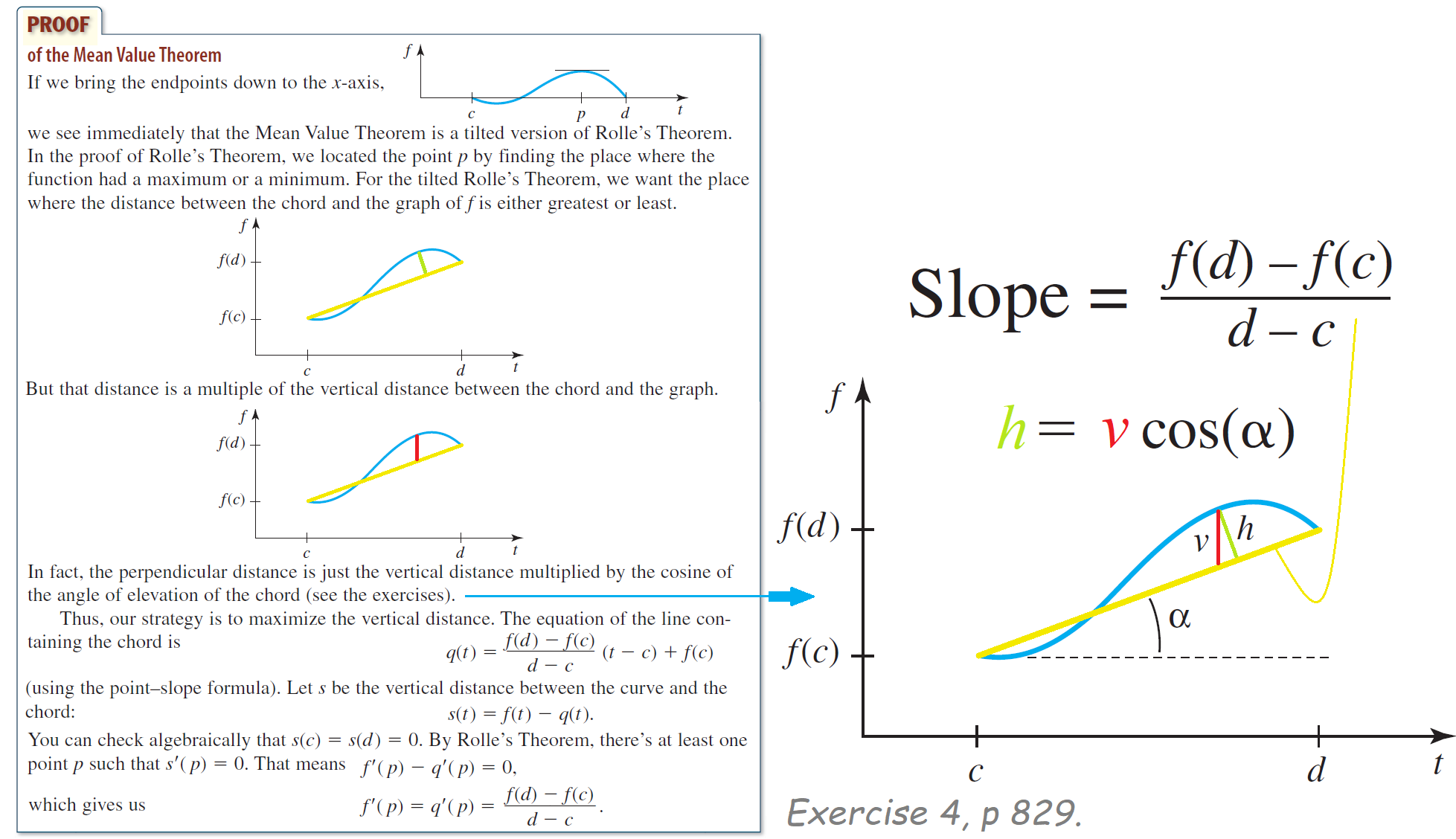Post History
#3: Post edited
- How can I transmogrify this figure for the [Generalized MVT](https://math.stackexchange.com/q/296176)? If $f$ and $g$ are continuous
- on the closed interval $[a, b]$ and differentiable on the open interval $(a, b)$,
then $\exists$ $c ∈ (a, b)$ $- \cfrac{f'(c)}{g'(c)} = \cfrac{f(b)-f(a)}{g(b)-g(a)}$.
Please don't just change the t-axis to $g(t)$.- 
- [*Calculus: The Language Of Change*](https://www.amazon.com/Calculus-Language-David-W-Cohen/dp/0763729477) (2005)
- by David W. Cohen, James M. Henle. [pp. 827-829](https://books.google.com/books?id=QNfZls4urMoC&pg=PA827&lpg=PA827&dq=mean+value+theorem+proof+tilt&source=bl&ots=WjLggTfZBQ&sig=5hcMBO1xjIv5xt7Fejr9C7LQkoM&hl=fr&sa=X&ei=vz0PU8KbOundigeLv4DwDQ&redir_esc=y#v=onepage&q&f=true). The original colored in just blue. I annotated and added more colors.
- How can I transmogrify this figure for the [Generalized MVT](https://math.stackexchange.com/q/296176)? If $f$ and $g$ are continuous
- on the closed interval $[a, b]$ and differentiable on the open interval $(a, b)$,
- then $\exists$ $c ∈ (a, b) \ni
- \cfrac{f'(c)}{g'(c)} = \cfrac{f(b)-f(a)}{g(b)-g(a)}$.
- Please answer with a picture. Please edit my scan, and draw or write in what you mean. Don't just change the t-axis to $g(t)$.
- 
- [*Calculus: The Language Of Change*](https://www.amazon.com/Calculus-Language-David-W-Cohen/dp/0763729477) (2005)
- by David W. Cohen, James M. Henle. [pp. 827-829](https://books.google.com/books?id=QNfZls4urMoC&pg=PA827&lpg=PA827&dq=mean+value+theorem+proof+tilt&source=bl&ots=WjLggTfZBQ&sig=5hcMBO1xjIv5xt7Fejr9C7LQkoM&hl=fr&sa=X&ei=vz0PU8KbOundigeLv4DwDQ&redir_esc=y#v=onepage&q&f=true). The original colored in just blue. I annotated and added more colors.
#2: Post edited
- How can I transmogrify this figure for the [Generalized MVT](https://math.stackexchange.com/q/296176)? If $f$ and $g$ are continuous
- on the closed interval $[a, b]$ and differentiable on the open interval $(a, b)$,
- then $\exists$ $c ∈ (a, b)$ $
- \cfrac{f'(c)}{g'(c)} = \cfrac{f(b)-f(a)}{g(b)-g(a)}$.
- Please don't just change the t-axis to $g(t)$.
- [*Calculus: The Language Of Change*](https://www.amazon.com/Calculus-Language-David-W-Cohen/dp/0763729477) (2005)
- by David W. Cohen, James M. Henle. [pp. 827-829](https://books.google.com/books?id=QNfZls4urMoC&pg=PA827&lpg=PA827&dq=mean+value+theorem+proof+tilt&source=bl&ots=WjLggTfZBQ&sig=5hcMBO1xjIv5xt7Fejr9C7LQkoM&hl=fr&sa=X&ei=vz0PU8KbOundigeLv4DwDQ&redir_esc=y#v=onepage&q&f=true). The original colored in just blue. I annotated and added more colors.
- How can I transmogrify this figure for the [Generalized MVT](https://math.stackexchange.com/q/296176)? If $f$ and $g$ are continuous
- on the closed interval $[a, b]$ and differentiable on the open interval $(a, b)$,
- then $\exists$ $c ∈ (a, b)$ $
- \cfrac{f'(c)}{g'(c)} = \cfrac{f(b)-f(a)}{g(b)-g(a)}$.
- Please don't just change the t-axis to $g(t)$.
- 
- [*Calculus: The Language Of Change*](https://www.amazon.com/Calculus-Language-David-W-Cohen/dp/0763729477) (2005)
- by David W. Cohen, James M. Henle. [pp. 827-829](https://books.google.com/books?id=QNfZls4urMoC&pg=PA827&lpg=PA827&dq=mean+value+theorem+proof+tilt&source=bl&ots=WjLggTfZBQ&sig=5hcMBO1xjIv5xt7Fejr9C7LQkoM&hl=fr&sa=X&ei=vz0PU8KbOundigeLv4DwDQ&redir_esc=y#v=onepage&q&f=true). The original colored in just blue. I annotated and added more colors.
#1: Initial revision
How can I generalize a picture for the Mean Value Theorem to the Generalized MVT?
How can I transmogrify this figure for the [Generalized MVT](https://math.stackexchange.com/q/296176)? If $f$ and $g$ are continuous
on the closed interval $[a, b]$ and differentiable on the open interval $(a, b)$,
then $\exists$ $c ∈ (a, b)$ $
\cfrac{f'(c)}{g'(c)} = \cfrac{f(b)-f(a)}{g(b)-g(a)}$.
Please don't just change the t-axis to $g(t)$.

[*Calculus: The Language Of Change*](https://www.amazon.com/Calculus-Language-David-W-Cohen/dp/0763729477) (2005)
by David W. Cohen, James M. Henle. [pp. 827-829](https://books.google.com/books?id=QNfZls4urMoC&pg=PA827&lpg=PA827&dq=mean+value+theorem+proof+tilt&source=bl&ots=WjLggTfZBQ&sig=5hcMBO1xjIv5xt7Fejr9C7LQkoM&hl=fr&sa=X&ei=vz0PU8KbOundigeLv4DwDQ&redir_esc=y#v=onepage&q&f=true). The original colored in just blue. I annotated and added more colors.


















